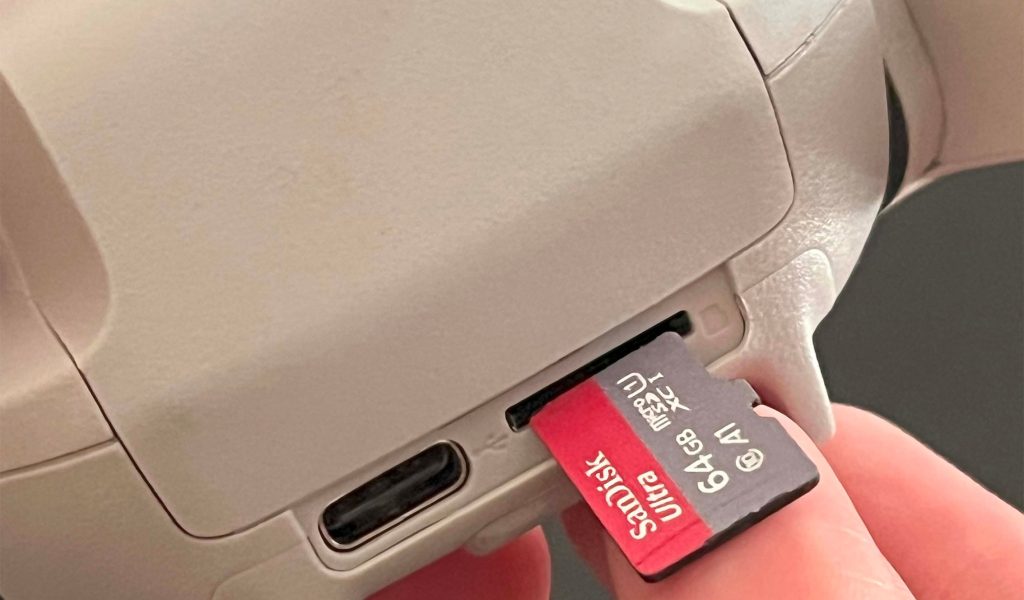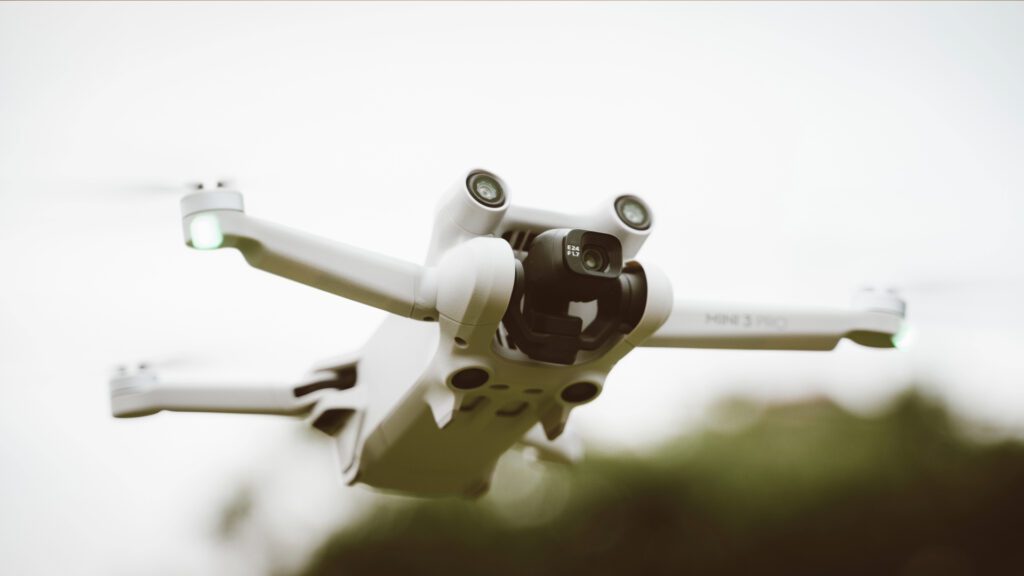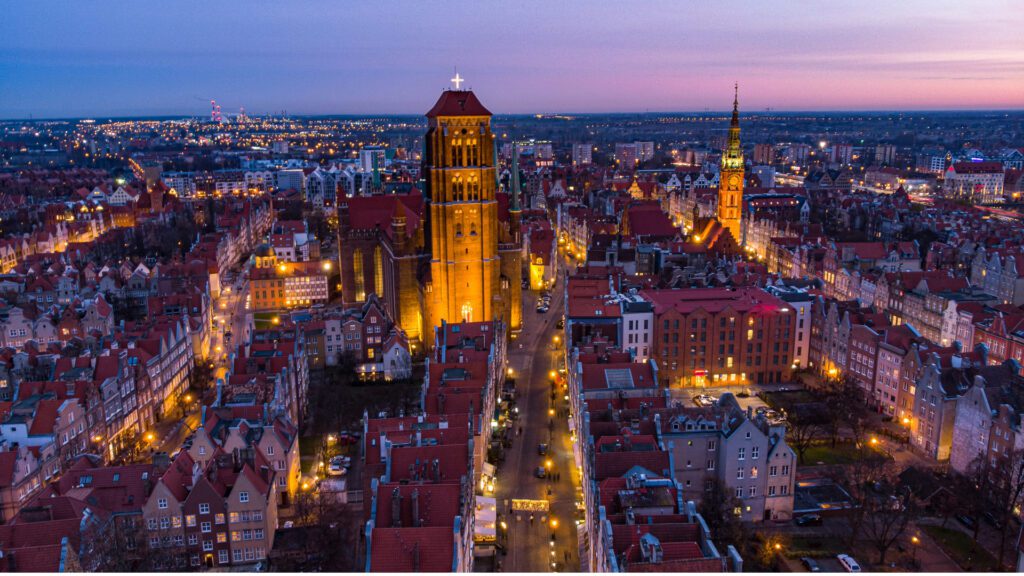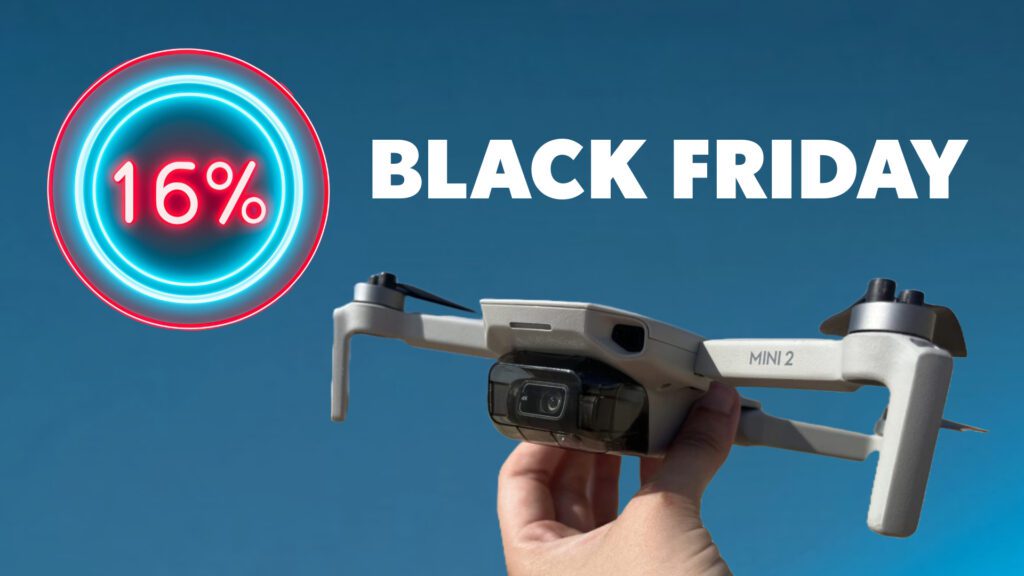We all know how thrilling it is to capture insane aerial footage or capture stunning sunset shots. But, guess what? Picking the best micro SD card for your drone is a big deal that often gets overlooked. And we’re here to help!
We’ll talk about compatibility, storage needs, write speeds, and durability—even how to read the specs of any micro SD card to guide your SD card decisions in the future.
We’ll discuss micro SD cards and specs relevant to DJI drones mostly, however these same tips apply to most drones that require SD cards such as; Parrot, Autel Evo Lite.
Understanding the Importance of Choosing the Best Micro SD Card for Drones
For most drones nowadays, the camera records standardly in 4K. And with drones such as the Mini 2 and Mavic Mini, there is no internal storage system. So if you don’t use an SD card, any shots you capture will be stored in a much lower resolution (720p) on your phone.
I’ve been there where I’ve left my SD card in my laptop only to take my drone out, take some snaps and the app doesn’t let me perform the cool automatic drone moves. And the videos I’ve taken that I think look like great quality, don’t look all that great when I go to look at them on my phone.
It’s also important to choose the right micro SD card. It can be overwhelming at first when there are so many brands, storage types and card speeds to choose from. Well have no fear, as we’re about to address all of them and get you the right micro SD card for you.
How to Read a Micro SD Card
So, you’re on the page to buy an SD card but wait a minute…
What do all these symbols mean? Do they matter?
Yes, they do matter. And they can affect whether or not they will work in your drone. Let’s understand these symbols.
Here’s what a standard SD card looks like:
- 64GB: This is the capacity of memory storage that the micro SD card can hold. These typically range from 16 GB to 1 TB.
- 3 in U shape: UHS speed class of 3. Class 3 is the minimum class for drones, any lower will not work.
- A2: Application performance class of 2. This is the speed of random read and write speeds. These typically come in A1 or A2 (newer model) but both work perfectly fine.
- V30: Video speed class of 30. This is the minimum write speed and will determine how your footage is recorded.
- XC: Stands for extra capacity and means it’s a higher storage card. For storage capacities lower, you will mostly like see it as HC, standing for high capacity.
Also, read what to consider when buying a drone.
Our Top Recommendations: Best Micro SD Card for Drones
Now that you understand the importance of choosing the right micro SD card for your drone, here are a few best micro SD cards for drones that we recommend.
These cards are also in line with DJI’s recommendations. Please note that many drones will not let you exceed 256GB of storage.
As mentioned before, it’s better to stick with big reputable brands so you don’t end up spending money with no return. These brands are: Samsung, SanDisk and Lexar.
As of June 2023, it seems the more affordable option on Amazon is to purchase a 64GB card rather than two 32GB cards for better value for money. A lot of lower storage SD cards also tend to be of a lower class rating so please be aware of this when purchasing for your drone.
1. SanDisk High Endurance 32GB
The SanDisk High Endurance is an ideal option for those who are just getting into drones and don’t require too much storage space – for a very affordable price.
With its exceptional durability, you can trust that it will capture and preserve crucial footage without worry. This microSD card is built to withstand extreme hot and cold conditions, whilst also shockproof and waterproof, ensuring the safety of your Full HD drone shots and/or 4K videos.
Designed for high endurance so you can record for up to 20,000 hours with no worries.
2. SanDisk Extreme 64GB
Specs: UHS-I, Class, 10, U3, V30.
SanDisk has been our go-to brand for micro SD cards for a while now. It’s proven great for extra phone storage, dash cams, Go-Pros and now our DJI Mini 2.
The U3 code reflects Class 3 which is the minimum requirement for drones. The V30 code means that you’re guaranteed 30 MB/s write speed but this does go up to 80MB/s for 64GB. These specs make the SanDisk Extreme a perfect choice for capturing fast-paced footage in stunning 4K and 5K videos, as well as high-quality HD photographs.
SanDisk has been our go-to brand for micro SD cards for a while now. It’s proven great for our DJI Mini 2.
You can also purchase it in 128GB and 256GB through the same link, which go up to 90 MB/s and 130 MB/s write speed, respectively.
3. Lexar High Performance 64GB
The Lexar High Performance 64GB is a solid option to effortlessly capture, store, and transfer your drone footage. This card delivers a speedy transfer rate of up to 95MB/s, allowing for seamless handling of 1080p full-HD, 3D, and 4K videos. In line with the class and write speeds of DJI, this micro SD card will prove a reliable companion in your drone hobby.
Quickly capture, playback, and transfer 1080p Full-HD, 3D, and 4K video.
4. Samsung Evo Plus 128GB and 256GB
These cards I’d say are aimed at drone enthusiasts wishing to use their drone professionally. You receive far more memory storage, optimal performance, and the write speeds are phenomenal.
It is specifically designed to meet the demands of recording 4K UHD videos, such as with your DJI Mini 2. Moreover, it excels in capturing high-resolution photos and videos, ensuring exceptional image quality.
With a read speed of 130MB/s, transfers for large files such as 4K videos are seamless and reliable. The Evo Plus card also offers protection against water, extreme temperatures, X-rays, magnets, drops, and wearout.
This card is specifically designed to meet the demands of recording 4K UHD videos, such as with your DJI Mini 2.
Check out other essential DJI Mini 2 accessories.
Factors to Consider When Selecting a Micro SD Card for Your Drone
The type of drone model you own, to the speed and storage capacity of the card, are all things you need to consider when selecting a micro SD card for your drone. Here, we will address what you’ll need to think about beforehand so you can rest assured you make the right purchase.
Type of Drone
Before you begin micro SD card shopping, you first need to consider what drone model you have as this can help decide what SD card is most suitable.
Let’s take the DJI Mavic Mini as an example. Since it doesn’t shoot videos in 4K, less memory would be needed to store the footage. Therefore, SD cards with capacities of 64GB and below would be most suitable for this drone.
Whereas, DJI products such as Mini 2, Mavic Pro and Mini 3 shoot videos in 4K – and even 5K. It’s important to consider the extra memory these videos are going to take up when stored. As such, you might want to opt for micro SD cards 64GB and over to ensure you don’t run out of storage space.
With larger storage space also comes a faster read speed, but more on this in the next section.
Speed and Performance
When it comes to choosing a micro SD card, speed and performance are crucial factors.
The speed of an SD card refers to how quickly it can read and write data, and it directly impacts the overall performance and usability of the card.
What is read and write speed?
The read speed of an SD card refers to how quickly data can be retrieved (transferred) from the card, while the write speed indicates how fast data can be written (recorded) onto the card.
Both speeds are important when using an SD card for tasks like recording videos or transferring files.
Most drones require a UHS-I Speed Class 3 or above as a minimum.
A fast write speed allows you to record high-resolution videos, burst-mode photos, or fast-action sequences without experiencing lag or buffering issues. Similarly, when it comes to transferring files from the SD card to a computer or other storage devices, a faster card significantly reduces the transfer time and allows uninterrupted playback.
As drones are high-speed machines with high resolution, choosing a card with lower speed capabilities may limit your ability to utilise advanced features, and may result in laggy playback of your videos. And that’s no fun for anyone!
Think of it this way: You wouldn’t record 4K movies to playback on a 90s square television screen because you wouldn’t be doing the video any justice.
Check out tips to master aerial photography with the DJI Mini 2.
Storage Capacity
The storage capacity of your micro SD card will depend on your intent with your drone. If you’re a casual flyer who enjoys capturing a few minutes of aerial footage during weekend adventures, a smaller memory card with a lower capacity might be ideal.
On the other hand, if you’re a professional aerial photographer or videographer who frequently engages in long and demanding shoots, opting for a higher-capacity SD card is ideal to ensure you won’t accidentally run out of storage space.
Let’s understand memory on micro SD cards:
| Micro SD card storage | Video storage (4K/60Mbps) | Video storage (2.7K/30fps) | Image storage (RAW vs JPEG) |
| 16 GB | 20 min | 30 – 40 min | 400 – 800 |
| 32 GB | 40 min | 60 – 90 min | 1, 000 – 1,100 |
| 64 GB | 80 min (1h 20m) | 2 – 3 hours | 2,100 – 2, 200 |
| 128 GB | 160 min (2h 40m) | 4 – 6 hours | 4, 300 – 4, 400 |
| 256 GB | 220 min (3h 40m) | 8 – 12 hours | 8, 700 – 8, 800 |
Please note the table is specific to drones and their respective bit rates. Also, these are approximations and may not be exact times.
For image storage, we have listed RAW vs JPEG, standard JPEG images are lower in quality and so will require less memory, allowing the micro SD card to store more of them.
32 GB and 64 GB (highlighted) are most commonly used for most drones as they balance between not worrying about running out of storage on a smaller card, and avoiding the unnecessary cost of purchasing a higher capacity card that won’t be fully utilised. The 16GB option however, is not recommended due to its highly limiting storage space, particularly for drone usage.
Some people prefer to buy two separate 32 GB SD cards to allow for them to be swapped in case of any formatting or corruption issues.
That said, if you are hoping to use your drone professionally for clients, say if you are capturing several pieces of footage before editing them, you might opt for a larger card around 128GB. This ensures you have ample storage space to capture a significant amount of footage before needing to transfer the files.
Durability and Endurance
The endurance and durability of an micro SD card refer to its ability to withstand various conditions and maintain reliable performance over time.
Endurance refers to the card’s resistance to frequent read and write operations, ensuring it can handle continuous usage without degrading or failing. Durability relates to the physical strength of the SD card, making it resistant to shocks, impacts, water and temperature variations that could potentially damage or corrupt the data stored on the card.
SD designed for continuous recording and high read/write cycles are often labelled as “high endurance” or “high performance”. Consider reputable brands such as Samsung, Lexar and SanDisk, as they are notable for producing high-quality and reliable SD cards.
How to Properly Install and Format an SD Card for Your Drone
So, you’ve got your brand new SD card and you’re itching to take off and start flying!
Here’s a quick guide on how to set up your SD card and get it ready for action, so you can stop delaying and get up there in the sky:
- Make sure your drone is powered off and locate the SD card slot. This is usually on the side or underneath the drone’s body.
- Carefully insert the SD card into the slot. It’ll slot in with a little click noise to ensure it’s secure.
- Power on your drone and navigate to the settings menu on the mobile app.
- Look for the option to format the SD card and select: “Format SD card”. Formatting will prepare the card for use, delete any files if it has been previously used, and ensure compatibility with your drone’s system.
- Once the formatting process is complete, you’re all done!
Remember to regularly backup and transfer your files to a computer or external storage to free up space on the SD card for future flights. By following these steps, you’ll have a properly installed and formatted SD card ready to record your drone’s adventures with confidence.
If you have received an error during formatting, you need to double check the specs of the SD card to make sure they are in line with your drone’s requirements.
Conclusion
Here are the key takeaways:
- Most drones require a UHS-I Speed Class 3 or above.
- A write speed minimum of 30 MB/s is typical.
- Stick with notable brands like Sandisk, Lexar, and Samsung.
- Define your intention with the drone and your drone’s minimum requirements before making a purchase.
FAQs: The Best Micro SD Cards for Drones
Can I use any SD card in my drone?
In short, no. Not all SD cards work with all drones.
Different drones may have specific requirements in terms of capacity, speed, and format. Therefore, it’s important to check the drone and/or manufacturer’s requirements for SD cards to ensure their compatibility before making a purchase.
Why does it say “SD formatting failed” on my drone?
An “SD formatting failed” message on your drone typically indicates an issue with the SD card.
There could be several reasons for this error, such as an incompatible or damaged SD card, insufficient storage capacity, or a problem with the drone’s firmware.
To troubleshoot the issue, try the following:
- Ensure that the SD card is inserted correctly in the drone’s SD card slot.
- Check if the SD card is compatible with your drone model and meets the recommended specifications.
- Make sure your drone’s firmware is updated to the latest version.
If the issue persists, consider trying a different SD card or contacting the drone manufacturer’s customer support.
What storage capacity should I choose for my drone’s SD card?
The answer to this depends on what you intend to use your drone for.
If your drone does not capture 4K videos – such as the DJI Mavic Mini – a lower storage capacity, such as 32GB or 64GB, may be sufficient. However, if you frequently shoot in high resolutions like 4K or 5K, or if you want to store a large number of photos and videos on your drone, opting for higher storage capacities like 128GB or 256GB would be more suitable.
What is the difference between read and write speed?
The read speed of an SD card refers to how quickly data can be retrieved or transferred from the card, while the write speed indicates how fast data can be written or saved onto the card.
Both speeds are important when using an SD card for tasks like recording videos or transferring files.
A high read speed of at least 30Mb/s is needed for drone use as it enables smooth recording of high resolution video footage, high quality images, and smooth playback of media files.








